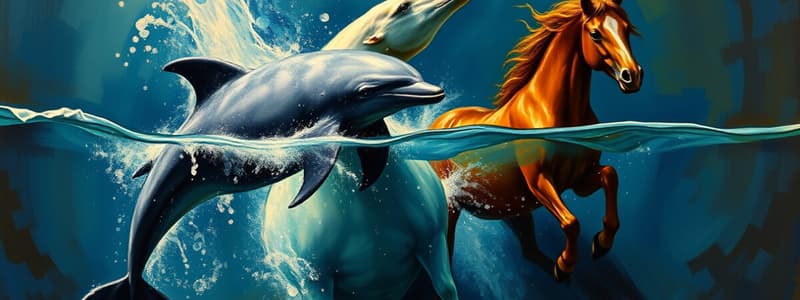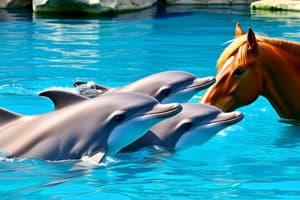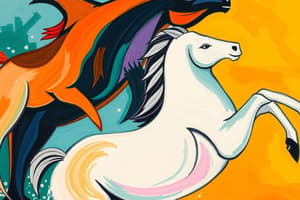Podcast
Questions and Answers
What type of waters do dolphins typically inhabit?
What type of waters do dolphins typically inhabit?
- Freshwater lakes
- Cold oceanic waters
- Moderate to warm ocean and sea waters (correct)
- Tropical rainforests
Where do domestic horses prefer to live?
Where do domestic horses prefer to live?
- Mountains and valleys
- Dense forests and jungles
- Plains, prairies, and steppes (correct)
- Coastal areas and beaches
What is the primary reason for the cheetah's endangerment?
What is the primary reason for the cheetah's endangerment?
- Loss of habitat and prey (correct)
- Changes in climate
- Increased poaching and hunting
- The spread of disease
What type of ecosystem is the African savanna?
What type of ecosystem is the African savanna?
What is one of the main threats to blue whales?
What is one of the main threats to blue whales?
What are conservationists trying to do for the lion population?
What are conservationists trying to do for the lion population?
What is the term used for the accidental catching of non-target species during fishing?
What is the term used for the accidental catching of non-target species during fishing?
What is one of the main threats to the blue whale population?
What is one of the main threats to the blue whale population?
At what age does a foal become a yearling?
At what age does a foal become a yearling?
Which animal is recognized as the fastest land animal?
Which animal is recognized as the fastest land animal?
How quickly can tiger cubs become fully grown adult tigers?
How quickly can tiger cubs become fully grown adult tigers?
What do many herbivores in the African savanna primarily eat?
What do many herbivores in the African savanna primarily eat?
Why do horses need open spaces?
Why do horses need open spaces?
What are crocodiles' life cycle stages, according to the description provided?
What are crocodiles' life cycle stages, according to the description provided?
What has caused habitat destruction for lions?
What has caused habitat destruction for lions?
What term describes the period during which a monkey develops inside its mother's belly?
What term describes the period during which a monkey develops inside its mother's belly?
What is a young hen called before it can lay eggs?
What is a young hen called before it can lay eggs?
What is the primary purpose of a cheetah's mantle fur when they are cubs?
What is the primary purpose of a cheetah's mantle fur when they are cubs?
What adaptation allows cheetahs to reach high speeds?
What adaptation allows cheetahs to reach high speeds?
What is the lifespan range of a hen based on environmental factors?
What is the lifespan range of a hen based on environmental factors?
Flashcards are hidden until you start studying
Study Notes
Dolphins
- Found in warm, moderate ocean and sea waters globally, with coastal species living near beaches and offshore species preferring deep waters.
- Travel in pods for food access and predator avoidance.
- Require clean water and abundant food sources.
Horses
- Domesticated horses can inhabit various environments, while wild horses thrive in plains, prairies, and steppes.
- Need spacious terrains for defense and shelter from elements like trees or cliffs.
- As herbivores, they mainly eat grass and necessitate fresh water availability.
Cheetahs
- Known as the fastest land animals, capable of reaching speeds up to 60 miles per hour.
- Endangered due to habitat loss, decreased prey availability, and threats from humans, hunters, and poachers.
African Savanna
- Covers almost half of Africa, situated between rainforests and deserts.
- Characterized by warm, open landscapes with diverse grasses supporting numerous large herbivores (e.g., giraffes, zebras, elephants) and carnivores (e.g., lions, hyenas, leopards).
- Endangered due to habitat destruction and hunting, emphasizing the need for protection.
Lions
- Various lion species face extinction risks due to habitat destruction from human expansion and declining prey.
- Conservationists are actively working to increase lion populations despite hunting and disease threats.
Blue Whales
- Endangered primarily due to historical whaling, which drastically reduced their numbers until illegal in 1966.
- Currently threatened by boat collisions, anthropogenic noise, pollution, climate change, and fishing impacts.
Great White Sharks
- Endangered due to human fear, pollution, illegal fishing, and bycatch.
- Increased protections, such as bans on shark fin soup, are contributing to population recovery efforts.
Snakes
- Distributed widely, particularly in warm tropical climates, inhabiting various ecosystems including forests, deserts, and aquatic environments.
- Regulate body temperature by moving within their habitat, such as seeking shade or sun as needed.
Horse Life Cycle
- Begins with a foal, transitioning to a yearling at one year, then to a colt (male) or filly (female) at two, reaching adulthood by four.
- Average lifespan is around 25 years.
Lion Life Cycle
- Lion cubs experience rapid growth, learning essential survival skills like walking and hunting before reaching sexual maturity under six years.
Tiger Life Cycle
- Starts as blind cubs needing maternal care, progressively learning to hunt and eventually becoming independent around 17 months to two years.
Crocodile Life Cycle
- Consists of three stages: pre-birth (nesting), youth, and adulthood, illustrating the full life cycle from egg to adult.
Monkey Life Cycle
- Begins in the womb during gestation, followed by stages of babyhood and adulthood, with a lifespan varying from 10 to 50 years depending on species.
Hens
- Hatch covered in down and are referred to as pullets until they can lay eggs.
- Can live 2 to 25 years or more, depending on environmental conditions.
Cheetah Cubs
- Born in litters of three to five, with a mantle for camouflage.
- Learn hunting skills through play, preparing them for independence.
Studying That Suits You
Use AI to generate personalized quizzes and flashcards to suit your learning preferences.




